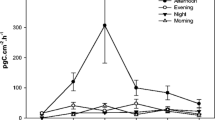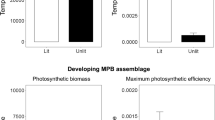Abstract
We have succeeded in culturing an axenic biofilm of the green sulfur bacterium Prosthecochloris aestuarii strain CE 2404 in an artificial sandy sediment under visible light (400–700 nm). This simulates the conditions of deep submerged sediments. A five-week incubation period, using a 16-hour light / 8-hour dark regime, was applied in the benthic gradient chamber (BGC). The biofilm was located below the oxygen penetration depth of 1.2 mm, namely between 1.5 and 2.5 mm and the biomass peak was at 2.1 mm depth. This is much shallower compared to previously described artificial mats of P. aestuarii, which were grown in the BGC under near infrared (NIR)-rich light. High resolution time courses of photosynthesis were measured as sulfide photo-oxidation rates and studied under visible light and visible light amended with NIR to assess the effect of light quality. Sulfide photo-oxidation rates were rather low under visible light and strongly stimulated at most depths under full light conditions. However, under the latter conditions the rates decelerated after a maximum rate was reached at 8–10 min, apparently due to diffusional limitation of sulfide supply. It was concluded that the top of the mat was not limited by the photon flux density, while the biomass peak and the bottom of the biofilm were severely light limited under the culture conditions. These results support the hypothesis that a biofilm of P. aestuarii can develop in deep submerged sediments, when the oxygen penetration depth is very shallow. Nevertheless, the addition of NIR light strongly enhances the potential of P. aestuarii to grow deeper in the sediment.
Similar content being viewed by others
References
Blankenship RE, Olson JM and Miller M (1995) Antenna Complexes from Green Photosynthetic Bacteria. In: Blankenship RE, Madigan MT and Bauer CE (eds) Advances in Photosynthesis Volume 2; Anoxygenic Photosynthetic Bacteria, pp 399–435. Kluwer Academic Publishers, Dordrecht / Boston / London
Borrego CM and Garcia-Gil LJ (1994) Separation of bacteriochlorophyll homologues from green photosynthetic sulfur bacteria by reversed-phase HPLC. Photosynth Res 41: 157–163
Borrego CM and Garcia-Gil LJ (1995) Rearrangement of light harvesting bacteriochlorophyll homologues as a response of green sulfur bacteria to low light intensities. Photosynth Res 45: 21–30
de Wit R (2000) Sulfide-Containing Environments. In: Encyclopedia of Microbiology, Volume 4, 2nd edition, pp 478–494. Academic Press
Epping E, Khalili A and Thar R (1999) Photosynthesis and the dynamics of oxygen consumption in a microbial mat as calculated from transient oxygen microprofiles. Limnol Oceanogr 44 (8): 1936–1948
Guyoneaud R (1996) Etude écologique, physiologique et systématique des communautés de bactéries phototrophes anoxygéniques en milieu lagunaire méditerranéen et atlantique. PhD thesis no 1387, Université Bordeaux I, France
Guyoneaud R, de Wit R, Matheron R and Caumette P (1998) Impact of macroalgal dredging on dystrophic crises and phototrophic bacterial blooms (red waters) in brackish coastal lagoon. Oceanologica Acta 21 (4): 551–561
Jeroschewski P, Steuckart C and Kühl M (1996) An amperometric microsensor for the determination of H2S in aquatic environments. Anal Chem 24: 4351–4357
Kirk JTO (1994) Light and Photosynthesis in Aquatic Ecosystems, 2nd edn. Cambridge University Press, Cambridge
Koch AL (1990) Diffusion; The Crucial Process in Many Aspects of the Biology of Bacteria. In: Marshall KC (ed) Advances in Microbial Ecology, Vol. 11, pp 37–70. Plenum Press, New York/London
Kühl M and Jørgensen BB (1992) Spectral light measurements in microbenthic phototrophic communities with a fiber-optic microprobe coupled to a sensitive diode array detector. Limnol Oceanogr 37 (8): 1813–1823
Lemaire E, Abril G, de Wit R and Etcheber H (2002) Distribution of phytoplankton pigments in nine European estuaries and implications for an estuarine typology. Biogeochemistry, in press
Millero FJ (1986) The thermodynamics and kinetics of the hydrogen sulfide system in natural waters. Mar Chem 18: 121–147
Pierson BK, Oesterle A and Murphy GL (1987) Pigments, light penetration, and photosynthetic activity in the multi-layered microbial mats of Great Sippewissett Salt Marsh, Massachussetts. FEMS Microbiol Ecol 45: 365–376
Pierson BK, Sands VM, and Frederick JL (1990) Spectral irradiance and distribution of pigments in a highly layered marine microbial mat. Appl Environ Microbiol 56: 2327–2340
Pringault O, de Wit R and Caumette P (1996) A benthic gradient chamber for culturing phototrophic sulfur bacteria on reconstituted sediments. FEMS Microbiol Ecol 20: 237–250
Pringault O, Kühl M, de Wit R and Caumette P (1998) Growth of green sulphur bacteria in experimental benthic oxygen, sulphide, pH and light gradients. Microbiology 144: 1051–1061
Pringault O, Epping E, Guyoneaud R, Khalili A and Kühl M (1999) Dynamics of anoxygenic photosynthesis in an experimental green sulphur bacteria biofilm. Environ Microbiol 1: 295–307
Revsbech NP and Jørgensen BB (1986) Micro-electrodes: Their use in microbial ecology. Adv Microb Ecol 9: 293–352
Revsbech NP (1989) An oxygen microsensor with a guard cathode. Limnol Oceanogr 34: 472–476
van Gemerden H (1984) The sulfide affinity of phototrophic bacteria in relation to the location of elemental sulfur. Arch Microbiol 139: 289–294
van Gemerden H and Mas J (1995) Ecology of Phototrophic Sulfur Bacteria. In: Blankenship RE, Madigan MT and Bauer CE (eds) Advances in Photosynthesis, Vol 2: Anoxygenic Photosynthetic Bacteria, pp 49–85. Kluwer Academic Publishers, Dordrecht / Boston / London
Vila X and Abella CA (1994) Effects of light quality on the physiology and the ecology of planktonic green sulfur bacteria in lakes. Photosynth Res 41: 53–65
Author information
Authors and Affiliations
Corresponding author
Rights and permissions
About this article
Cite this article
Massé, A., Pringault, O. & de Wit, R. Effect of light quality on sulfide photo-oxidation and growth in an artificial biofilm of the green sulfur bacterium Prosthecochloris aestuarii . Photosynthesis Research 71, 173–183 (2002). https://doi.org/10.1023/A:1014968017483
Issue Date:
DOI: https://doi.org/10.1023/A:1014968017483




